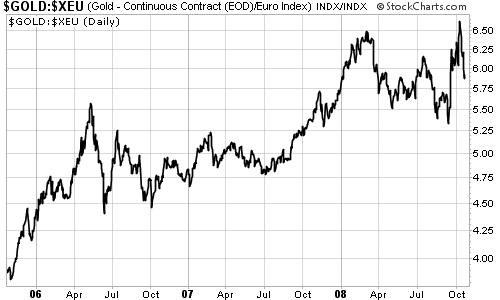| Home | About Us | Resources | Archive | Free Reports | Market Window |
Why Isn't Gold's Price Higher?By
Saturday, October 25, 2008
I get this question from time to time. Personally, I am amazed that gold held up so well in the past few months. Gold is down about 7% from a year ago. Compare this with any stock market and any currency.  Also, it is good to look at the long-term picture of gold. It reached a peak of $850 back in 1980 and then fell into a long, 20-year bear market. For an asset to work its way back to its previous high after so long means that something impressive is going on. All that is happening is that in terms of the U.S. dollar, gold is simply taking a rest after a huge run-up from $252 in 2001 to $1,030 last March. Let it rest and build a new base. Long-term holders will be rewarded, as current holders in Europe, the U.K. and most other countries already are. Keep in mind gold's outlook for the next five to 10 years... The world's central banks continue to try anything to get banks to lend their newly created money and thus stop the deflation danger. The Fed has been buying unsecured commercial paper. Governments are now taking ownership positions in big banks, offering them money in exchange for lending it out. I remain unconvinced that the banks will lend again to the average borrower. They may start lending to other banks, but this is not the same thing. Thus, the immediate danger is still for a deflation, and even a possible deflationary depression, as credit continues to dry up and people and companies that have borrowed too much continue to be in trouble. But further out, the vast inflation of money and credit that has been going on by the world's central banks will, after some time lag, start to cause price inflation to soar. Gold and silver look relatively weak now, but in time they will rise. I'm not really worried. I continue to take the long view on both metals and urge you to do so as well. Indeed, I am worried that the massive inflation and government intervention we are seeing will bring back a rush into these two inflation hedges.
I think we will see a plunging value of paper currencies in the future, with prices of gold and silver soaring. I don't like to say this because this could come along with other forms of instability. It looks like we are entering a period where people will become much less wealthy than they thought they were.
Further Reading:
A Long-Term Look at Gold and Silver Market NotesCRUDE'S TRENDLINE IS BROKEN
The trendline in crude oil we just featured on October 17 has been broken.
As we covered in that column, "the market" likes the bearish argument for crude oil right now: The world economy is now in a recession... and a recession squashes demand for gasoline, diesel, and all other types of petrochemicals. As you can see from this week's chart, the recent decline below $65 a barrel has broken the long uptrend oil began in 2002. We stand by our prediction... This "breaking" will get worse. – Brian Hunt |
Recent Articles
|

